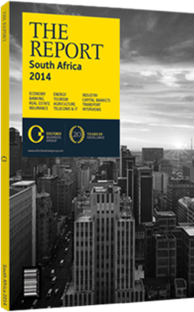Financial services
The Company
FirstRand is the third-largest South African bank by balance sheet size, holding total assets of R895bn ($84.8bn) as of December 31, 2013. It operates three primary brands: First National Bank, with a retail and commercial focus; Rand Merchant Bank, which competes in the corporate and investment banking markets; and Wesbank, providing vehicle and asset finance products. FirstRand is listed on the Johannesburg Stock Exchange and has a diverse institutional shareholder base. The largest shareholder, with a 33.9% stake, is RMB Holdings.
Performance
FirstRand has a June year-end date and reported IFRS pre-tax profits of R12.42bn ($1.18bn) and diluted EPS of R1.60 ($0.15) for the halfyear ended December 31, 2013. Market consensus predicts pre-tax profit of R24.6bn ($2.3bn) and EPS of R3.16 ($0.30) for the year ending June 30, 2014.
In the financial half year ended December 31, 2013, the company derived 56% of its profit from First National Bank and 27% from Rand Merchant Bank, while Wesbank contributed 17%. The company delivered a 23.4% ROE, driven by an industry-leading ROA of 2%. At December 31, 2014, FirstRand’s common equity Tier 1 ratio (a key measure of regulatory capital) was 13.7%, well above regulatory minimums.
The company’s strategy in the aftermath of the global financial crisis has been to reorient the positioning of its businesses. At First National Bank emphasis has been placed on growing the transactional and deposit franchise and adjusting the pricing of risk. Rand Merchant Bank has seen its business model transition from being a highly leveraged market-risk-oriented business to one more geared towards facilitating customer flows. In addition, emphasis has been placed on growing Rand Merchant’s lending activities. Wesbank has also seen adjustments in the pricing of risk, while significant emphasis has been placed on improving the unit’s operational efficiency.
In 2013 FirstRand also established a new division, Ashburton Investments, an investment management franchise. The rationale behind establishing this business was to plug a gap in FirstRand’s portfolio, as it had no meaningful asset management presence since unbundling its insurance and asset management business, Momentum, a few years earlier. Furthermore, the ROE profile of an investment management business, if successful, can be quite high.
Operating Environment
The bank derives approximately 90% of its revenue from its operations in South Africa, with the majority of other revenue coming from its activities in the rest of Africa.
Given the strong linkage between a country’s economy and its banking system, FirstRand is heavily influenced by the state of the South Africa economy. The pace of economic growth in the country has been sluggish recently, with the economy delivering growth in nominal GDP of approximately 8% in 2013 and real GDP growth in the region of 2%. Similar levels of growth have been forecast for 2014. Reflecting slower economic growth, total banking credit formation in South Africa has slowed in recent years, totalling 8% in 2013, compared to a 10-year average of 12%.
Banks are also heavily influenced by the interest rate cycle. Following a reduction in rates from 12% in late 2008 to 5% in 2012, the interest rate cycle in South Africa has turned. After the two interest rate hikes so far in 2014, the South African repo rate currently stands at 5.75%, with market expectations of further interest rate hikes from 2014 to mid-2016. Although higher interest rates boost the endowment income earned by banks, they also carry the risk of triggering deterioration of credit quality.
The rest of Africa is a priority for FirstRand’s expansion, setting aside R10bn ($947m) in 2013 for investment in the region in coming years, largely driven by materially higher economic growth rates in the rest of Africa as compared with domestic rates. Previous expansion has been organic in nature, and while the company has looked at several possible deals, no significant acquisitions have been concluded so far.
You have reached the limit of premium articles you can view for free.
Choose from the options below to purchase print or digital editions of our Reports. You can also purchase a website subscription giving you unlimited access to all of our Reports online for 12 months.
If you have already purchased this Report or have a website subscription, please login to continue.

